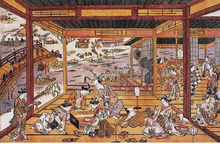Uki-e

This early example of an uki-e print uses Western-style perspective for the interior, but more traditional Japanese technique for the exterior.

Collection the Cincinnati Art Museum
Uki-e (浮絵, "floating picture", implying "perspective picture") refers to a genre of ukiyo-e pictures that employs western conventions of linear perspective. Although they never constituted more than a minor genre, pictures in perspective were drawn and printed by Japanese artists from their introduction in the late 1730s through to the mid-nineteenth century.[1]
Around 1739,
Guardi
. Toyoharu was also the first to adapt these techniques to Japanese subjects.
The interior of Kabuki theaters was a common subject in Uki-e prints. Interior scenes tend to be favored as it is easier to accurately apply one point perspective to architecture than to landscape.[1]
See also
- Rangaku
- Yokohama-e
- Yōga (art)
Citations
References
- Bayou, Hélène (2004). Réunion des musées nationaux (ed.). Images du Monde flottant: Peintures et estampes japonaises XVIIe-XVIIIe siècles (in French). ISBN 978-2-7118-4821-8.
- Hockley, Allen (2006). Public Spectacles, Personal Pleasures: four centuries of Japanese prints from a Cincinnati collection. Cincinnati: Cincinnati Art Museum. ISBN 0-931537-29-0.
- Seiichi, Iwao; Teizō Iyanaga (2002). Dictionnaire historique du Japon, Volume 2 (in French). Maisonneuve & Larose.
External links
 Media related to Uki-e at Wikimedia Commons
Media related to Uki-e at Wikimedia Commons- Short article about the genre

